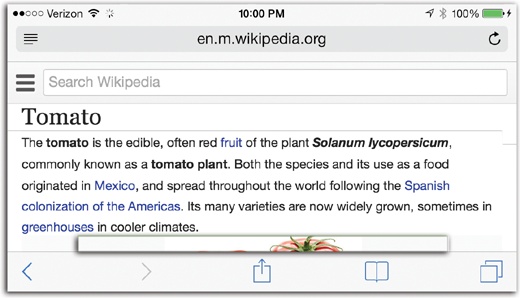Chapter 10. Getting Online
The iPhone’s concept as an all-screen machine is a curse and a blessing. You may curse it when you’re trying to type text, wishing you had real keys. But when you’re online—oh, baby. That’s when the Web comes to life, looming larger and clearer than you’d think possible on a cellphone. That’s when you see real email, full-blown YouTube videos, hyper-clear Google maps, and all kinds of Internet goodness, right in your hand.
And it’s fast, too, at least if you have an iPhone 5, 5c, or 5s. And you’re in one of the cities covered by 4G LTE cellular towers. And the gods are smiling.

A Tale of Two Connections
The iPhone can get onto the Internet using either of two methods—two kinds of wireless networks. Which kind you’re on makes a huge difference to your iPhone experience; there’s nothing worse than having to wait until the next ice age for some Web page to arrive when you need the information now.
Cellular Networks
Once you’ve accepted the miracle that a cellphone can transmit your voice wirelessly, it’s not much of a stretch to realize that it can also transmit your data. Cellphone carriers (Verizon, AT&T, and so on) maintain separate networks for voice and for Internet data—and every year, they spend billions of dollars trying to make those Internet networks faster. Over the years, they’ve come up with data networks like these:
Old, slow cellular network. The earliest, ...
Get iPhone: The Missing Manual, 7th Edition now with the O’Reilly learning platform.
O’Reilly members experience books, live events, courses curated by job role, and more from O’Reilly and nearly 200 top publishers.

